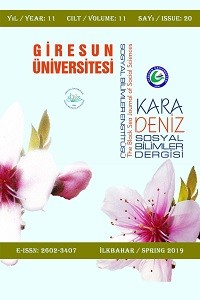Öz
Ortaçağ’da bazen savaş veya barışın konusu olan ve yine zaman
zaman milletlerarası işbirliği ve yakınlaşmaların gerekçesi olarak görülebilen
ipeğin Bizanslılar için diğer devletlerde olduğundan çok daha fazla hayati bir
önemi vardı. Sembolik anlamlarının yanında, ipek ve ipekli giysiler Bizans
dünyası içinde gündelik yaşamdan askerî, politik ve
diplomatik ilişkilere kadar birçok yerde kullanılmaktaydı. Ancak başlangıçta
tamamen ithal etme yoluyla sahip olunabilen bu ürünün tedariki oldukça
pahalıydı. Daha sonraları ipek üretme kabiliyetini elde eden Bizanslılar kısa
zaman içinde kendi bölgesinde ipek ticaretinde bir tekel gücüne sahip oldular
ve bu gücü dış politika amaçlarına ulaşmak için sıklıkla kullandılar. Bu
çalışmada Bizans ipek endüstrisinin oluşumu, ipeğin rolü ve Bizanslılar
tarafından muhtelif maksatlarla kullanımı ele alınmaktadır.
Anahtar Kelimeler
Kaynakça
- KaynakçaANDREADES, A. M. (1948). “The Economic Life of the Byzantine Empire”, Byzantium: An Introduction to East Roman Civilization, (Ed. Norman H. Baynes ve H. St, L. B. Moss). Oxford: Clarendon Press, s.51-70.ANGOLD, M. (1984). The Byzantine Empire 1025-1204: A Political History. New York: Longman Group.ANNA KOMNENE (2000). The Aexiad, (İng. Çev. Elizabeth A. S. Dawes). Cambridge, Ontario: In Parentheses Publications.AYÖNÜ, Y. (2014). Selçuklular ve Bizans. Ankara: Türk Tarih Kurumu Yayınları.BALL, J. L. (2005). Byzantine Dress: Representations of Secular Dress in Eighth – to Twelfth - Century Painting. New York: Palgrave Macmillan.BENJAMİN DE TUDELA (1907). The Itinerary of Benjamin of Tudela, (İng. Çev. Marcus Nathan Adler), London: Oxford University Press.BROWNİNG, R. (1992). The Byzantine Empire. Washington, D.C.: The Catholic University of America Press.CIGAAR, K. N. (1996). Western Travellers to Constantinople: The West and Byzantium, 962-1204 : Cultural and Political Relations. Leiden, New York, Köln: E.J. Brill.CUTLER, A. (2001). “Gifts and Gift Exchange as Aspects of the Byzantine, Arap and Related Economics”, Dumbarton Oaks Papers. No. 55, s. 247-278.ÇAKALGÖZ, S.Y. ve Eltez, S. (2014). “Ceroplastes Rusci L. (Hemiptera: Coccidae) Dişi Bireylerinin Kabuklarından Antik Dönemlerde Kullanılan Boya Çıkarma Yöntemleri ile Boya Eldesi”, Pamukkale Üniversitesi Sosyal Bilimler Enstitüsü Dergisi, Sayı 17, s. 39-44. DAVIES, N. (2011). Avrupa Tarihi: Doğu’dan Batı’ya Buz Çağı’ndan Soğuk Savaş’a Urallar’dan Cebelitarık’a Avrupa’nın Panoraması. İstanbul: İmge Kitapevi.DVORNIK, F. (1974). Origins of Intelligence Services: The Ancient Near East, Persia, Greece, Rome, Byzantium, the Arab Muslim Empires, the Mongol Empire, China, Muscovy. New Brunswick, New Jersey: Rutgers University Press. FELTHAM, H. B. (2009). “Justinian and the International Silk Trade”, Sino-Platonic Papers, No. 194, s.1-40.GALLIKER, J. L. (2014). Middle Byzantine Silk in Context: Intergrating the Textual and Material Evidence, (Yayınlanmamış Doktora Tezi). University of Birmingham, Centre for Byzantine, Ottoman and Modern Greek Studies.HARRIS, Jennifer, (1993). Textiles, 5,000 Years: An International History and Illustrated Survey. H. N. Abrams.HARRIS, Jonathan, (2003). Byzantium and Crusades. New York, London: The Bath Press.HENDY, M. F. (1985). Studies in the Byzantine Monetary Economy c.300-1450. Cambridege, New York: Cambridge University Press.IOANNES KİNNAMOS (1976). The Deeds of John and Manuel Comnenus, (İng. Çev. C.M. Brand). New York: Columbia University Press.JACOBY, D. (2004). “Silk Economics and Cross-Cultural Artistic Interaction: Byzantium, the Muslim World, and the Christian West”, Dumbarton Oaks Papers. No. 58, s.197-240.KONSTANTINOS PORPHYROGENİTOS (1967). De Administrando Imperio, (İng. Çev. R.J.H. Jenkins). New York: Dumbarton Oaks Center. KURAT, A. N. (1937). Peçenek Tarihi. İstanbul: Devlet Basımevi.LAIOU, A. E. (2002). “Exchange and Trade, Seventh-Twelfth Centuries”, The Economic History of Byzantium: From the Seventh through the Fifteenth Century. Washington D. C.: Dumbarton Oaks Studies, s. 697-770. LIU, X. (1996). Silk and Religion: An Exploration of Material Life and the Thought of People AD 600 – 1200. New Delhi: Oxford University Press. LOPEZ, R. S. (January, 1945). “Silk Industry in the Byzantine Empire”, Speculum: A Journal of Medieval Studies, Vol. 20, No. 1, s. 1-42.MADGEARU, A. (2013). Byzantine Military Organization on the Danube, 10th-12th Centuries. Leiden, Boston: Brill. MİKHAİL PSELLOS, (1953). The Cronographia of Michael Psellus, (İng. Çev. E.R.A. Sewter), Lodon: Routledge & Kegan Paul Books.MUTHESIUS, A. M. (1992). “Silk, Power And Diplomacy In Byzantium”, Textiles in Daily Life: Proceedings of the Third Biennial Symposium of the Textile Society of America, September 24–26, 1992, s. 99-110.NICOL, D. M. (2000). Bizans ve Venedik: Diplomatik ve Kültürel İlişkiler Üzerine Bir Araştırma, (Çev. Gül Çağalı Güven), İstanbul: Sabancı Üniversitesi Yayınevi.OIKONOMIDES, N. (2002). “The Role of the Byzantine State in the Economy”, The Economic History of Byzantium: From the Seventh Through the Fifteenth Century, (Ed. Angeliki E.Laiou), Vol. 3, Washingon D.C.: Dumbarton Oaks. OSTROGORSKY ,G. (2006). Bizans Devleti Tarihi, (Çev. Fikret Işıltan). Ankara: Türk Tarih Kurumu Yayınları.PILTZ, E. (2004). “Middle Byzantine Court Costume”, Byzantine Court Culture from 829 to 1204, (Ed. Henry Maguire), Washington D.C.: Harvard University Press, s. 39-51. QADDUMI, G. H. (1996). Book of Gifts and Rarities ((Kitâb al-Hadâyâ wa al-Tuhaf), Cambridge, Massachusets: Harward University Press. TAISHAN, Y. (2004). “A History of the Relationship Between the Western & Eastern Han, Wei, Jin, Northern & Southern Dynasties and the Western Regions”, Sino-Platonic Papers, No. 131. TEZCAN, M. (2014). “İpek Yolu’nun İran Güzergâhı ve İpek Yolu Ticaretine İran Engellemesi”, Uluslararası Türkçe Edebiyat Kültür Eğitim Dergisi, Sayı: 3/1, s. 96-123.THORLEY, J. (1965). The Development of Trade to the End of the Second Century A. D. Between the Eastern Provinces of the Roman and the Countries Lying Further East. (Yayınlanmamış Yüksek Lisans Tezi). Durham University. TURAN, O. (2004). Selçuklular Zamanında Türkiye: Siyasî Tarih Alp Arslan’dan Osman Gâzi’ye (1071-1318). İstanbul: Ötüken Neşriyat.______ (2009). Türk Cihân Hâkimiyeti Mefkûresi Tarihi: Türk Dünya Nizâmının Millî, İslâmi ve İnsanî Esasları, İstanbul: Ötüken Yayınevi.UPSHUR, J. L., TERRY, J.J., HOLOKA, J. P., CASSAR, G. H. ve GOFF, R. D. (2015). Cengage Advantage Books: World History, Boston: Wadsworth.VASILIEV, A. A. (1943). Bizans İmparatorluğu Tarihi, I. (Çev. Ali Müfid Mansel), Ankara: Maarif Matbaası.______ (1948). “Imperial Porphyry Sarcophagi in Constantinople” Dumbarton Oaks Papers, Vol. 4, Cambridge, Massachusets: Harvard University Press, s. 1-26.WALKER, A. (2012). The Emperor and the World: Exotic Elements and Imaging of Middle Power, Ninth to Thirteenth Centuries C.E., Cambridge University Press.
Ayrıntılar
| Birincil Dil | Türkçe |
|---|---|
| Bölüm | Makaleler |
| Yazarlar | |
| Yayımlanma Tarihi | 17 Haziran 2019 |
| Gönderilme Tarihi | 15 Ocak 2019 |
| Yayımlandığı Sayı | Yıl 2019 Cilt: 11 Sayı: 20 |


